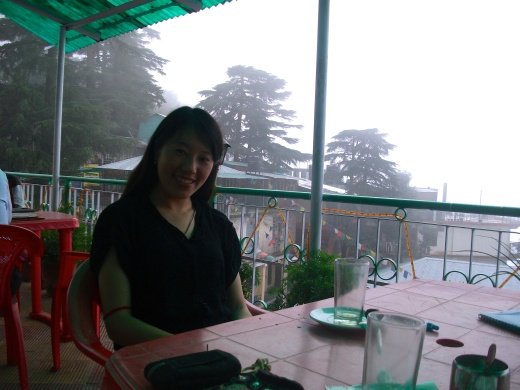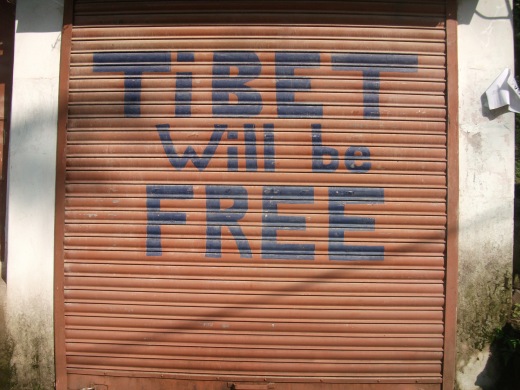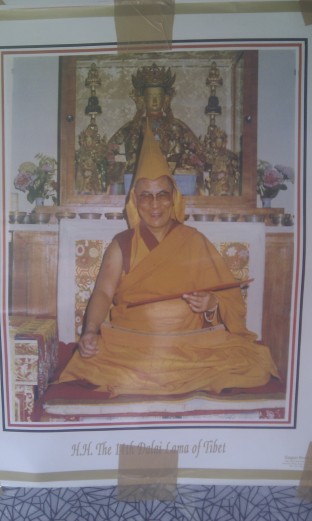I meet Dolma for the first time in the library of the LHA office in McLeod Ganj. She is sitting with Tenzin, the volunteer coordinator, and rises as I come in. She has long dark hair and is dressed in skinny jeans. Although a little shy in her demeanor, her smile is broad and warm. She greets me in lilting English and I realise that my job as her English tutor is going to easier then I imagined. She wonders if we can work on her pronunciation and selects a teenage murder-mystery book from the library to read from, before guiding me to a nearby rooftop café. There we sit on red plastic chairs and drink masala chai, surrounded by young Tibetans enjoying banana lassies and monks indulging in chocolate muffins.
Several people I met in India had recommended volunteering with LHA, an organisation for Tibetan refugees. The experience was highly positive from the word go. On-line registration was seamless and when I made my first appearance at the office, both Tenzin and the other volunteer coordinator, Bob, were incredibly helpful. Bob quickly pulled my details from the database and within a day, Tenzin had put Dolma and I in contact. It really couldn’t have been any easier.
As with many volunteering experiences, I had the feeling from the start that I was gaining more than I was giving. During our time together, we worked hard on pronunciation and discussed the idiosyncrasies of English grammar and spelling. Sometimes we even lapsed into French vocabulary-learning, as Dolma is studying French too. But in between, we chatted, and Dolma told me about her life. I was fascinated to hear about her escape from Tibet and how she had come to be in McLeod Ganj. She told me also about Tibet and gave me insights into Buddhist practices.
Dolma escaped from Tibet three years ago when she was 19, along with her sister Lalo, who is a year younger. Their father had to pay 40,000 Yuan (about 5,000 euro) to a guide to bring them out of the country. A huge sum of money for a farming family. The journey began when they set out from their village to Lhassa by bus. They then hid in a canned goods van in order to cross the border. From there, they walked for three nights in the dark with only a torch to guide them. The first night was the most dangerous. If the Chinese were to catch them, they would be put into prison.
Eventually, they reached Nepal and went to stay with an uncle in Kathmandu. There, using her knowledge of Chinese, Dolma found work. She helped her uncle with the administration of his business and taught Chinese to Nepali business men. The money was good, but she yearned to continue her schooling while also helping the Tibetan community. And so she and her sister came to Dharmasala. They both attended school and when Dolma graduated, she began working as a volunteer teacher at LHA, teaching Chinese to her fellow Tibetans. Knowledge of Chinese allows Tibetans to return to their home country and live and work there. Without the language, they are outcasts. The classic story of the occupied country. Being Irish, I could certainly relate to it.
Dolma’s days are busy. She teaches, she helps out in the kitchen of the restaurant owned by the Tibetan family she lodges with, and she studies English and French. Once a week she meets with a monk who is teaching her to write Tibetan. She can speak standard Tibetan, but she never had the chance to learn how to write it when she lived in Tibet. Everything she learnt was through Chinese.
But the most important time of the day for Dolma is first thing in the morning, when she goes to the main temple in order to do her prostrations to Lord Buddha. One morning I joined Dolma there. Arriving at 6.30am, I found that she was still practicing. I sat on a bench while I waited for her. In the main gompa, monks were chanting and blowing trumpets. A mystical sound. All around the exterior of the gompa, on two levels, others of all ages completed their prostrations also – bringing their hands, in prayer position, to the crown of their heads, mouth and throat and then bowing down in order to slide their bodies full length on wooden boards. When Dolma finally joined me, she showed me the number on her pink prostration-counter which she wore on her finger. She was out of breath, which was no wonder: she had completed 236 prostrations. It was hard not to be impressed with the level of her devotion.
Later at breakfast, I witnessed her faith once again. When a fly crash-dived into my scalding-hot tea, she quickly rescued him. I presumed, given the temperature of the tea, his chances of resuscitation were low to none, but unperturbed, Dolma held the fly in her cupped hands, blowing on him and chanting “Om mani padme hum”, the traditional Tibetan mantra. She laid it on the table and we continued the lesson. The fly was unmoving. I presumed he was a gonner. But after a few minutes, the small body began twitching. Delighted, Dolma scooped him up, said a few more mantras, and placed him in a safe corner to continue recuperating. Later that week, I had another kawasaki fly nose-dive into my tea. Fishing him out, I followed the mantra-plus-blowing routine, but to no avail. Perhaps Dolma’s mantras, given that they are so steeped devotion and faith, were stronger than mine? Or perhaps it was just the fly’s karma to go out like that…
Dolma says that she wanted to be a policewoman when she was little. She would have enjoyed sorting out problems. But she soon realised that would not be possible, so now she has set her sights on being a translator. She rarely gets to speak to her family, as a regular call from India could arouse Chinese suspicions, but when she does, they always tell her to come home if she is not happy. She says that she doesn’t have any close friends in McLeod, but feels that she does not need them. She has her younger sister, and besides, she is happy with her life for now– learning languages and helping her compatriots to learn Chinese. She would like to get married one day, but she is in no hurry.

Typical anti-drugs sign around McLeod Ganj. With access to education and employment being limited for Tibetan refugees, despondency can be a factor
On the day before I leave McLeod and head for Kashmir, Dolma and I meet for a final lesson. She is relaxed with me now and squeezes my arm as she wipes a black smudge off my cheek. She wishes me well on my travels and wonders if I have any friends with whom she could practice her English. Foreigners never seem to stay very long. She is happy when I tell her I’ve passed her number on to a couple of fellow travellers. We embrace as we go our separate ways and promise to meet some day in the future when she comes to visit Paris…perhaps under the Eiffel Tower.
For more about LHA and the volunteering opportunities it offers, see: http://www.lhasocialwork.org





